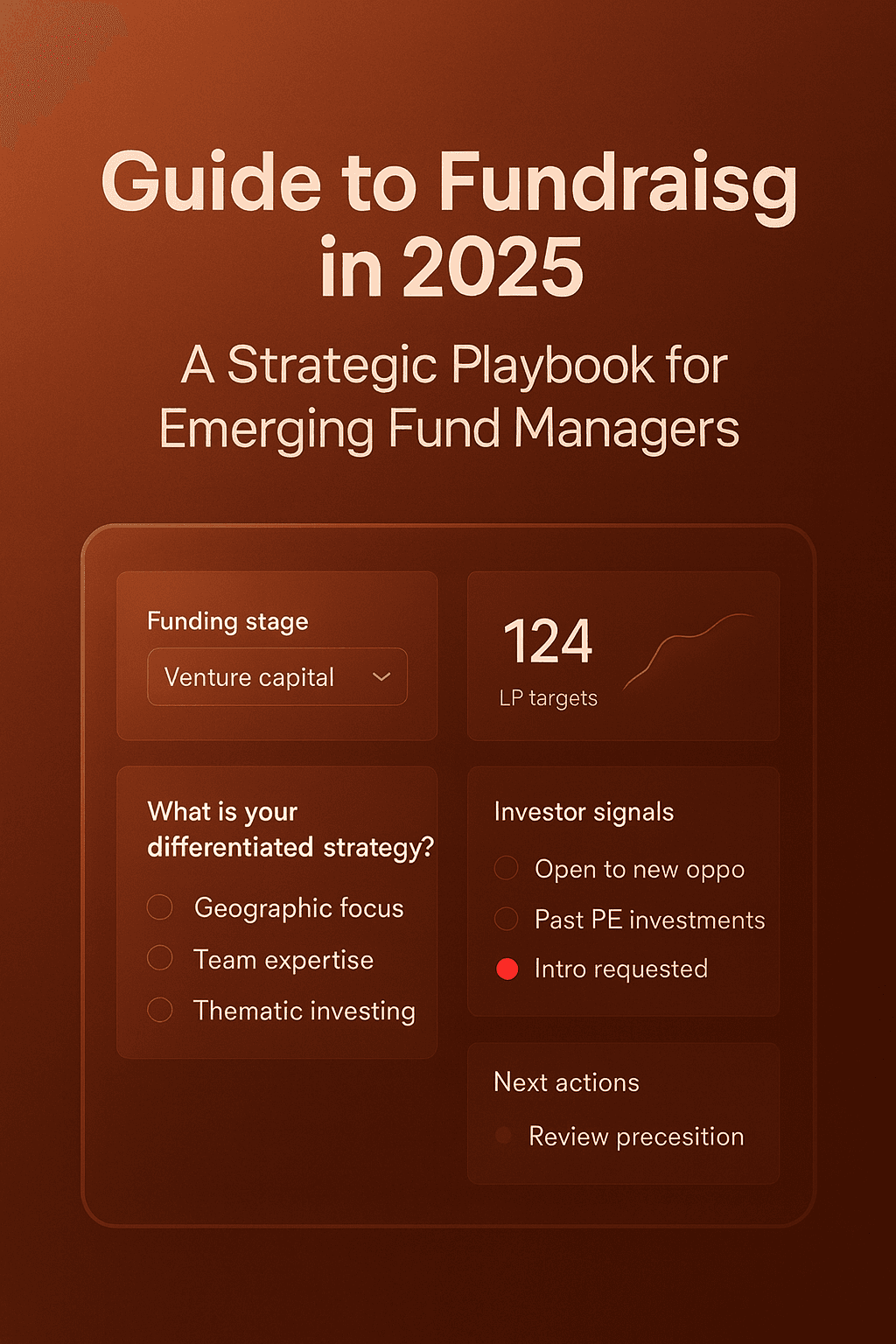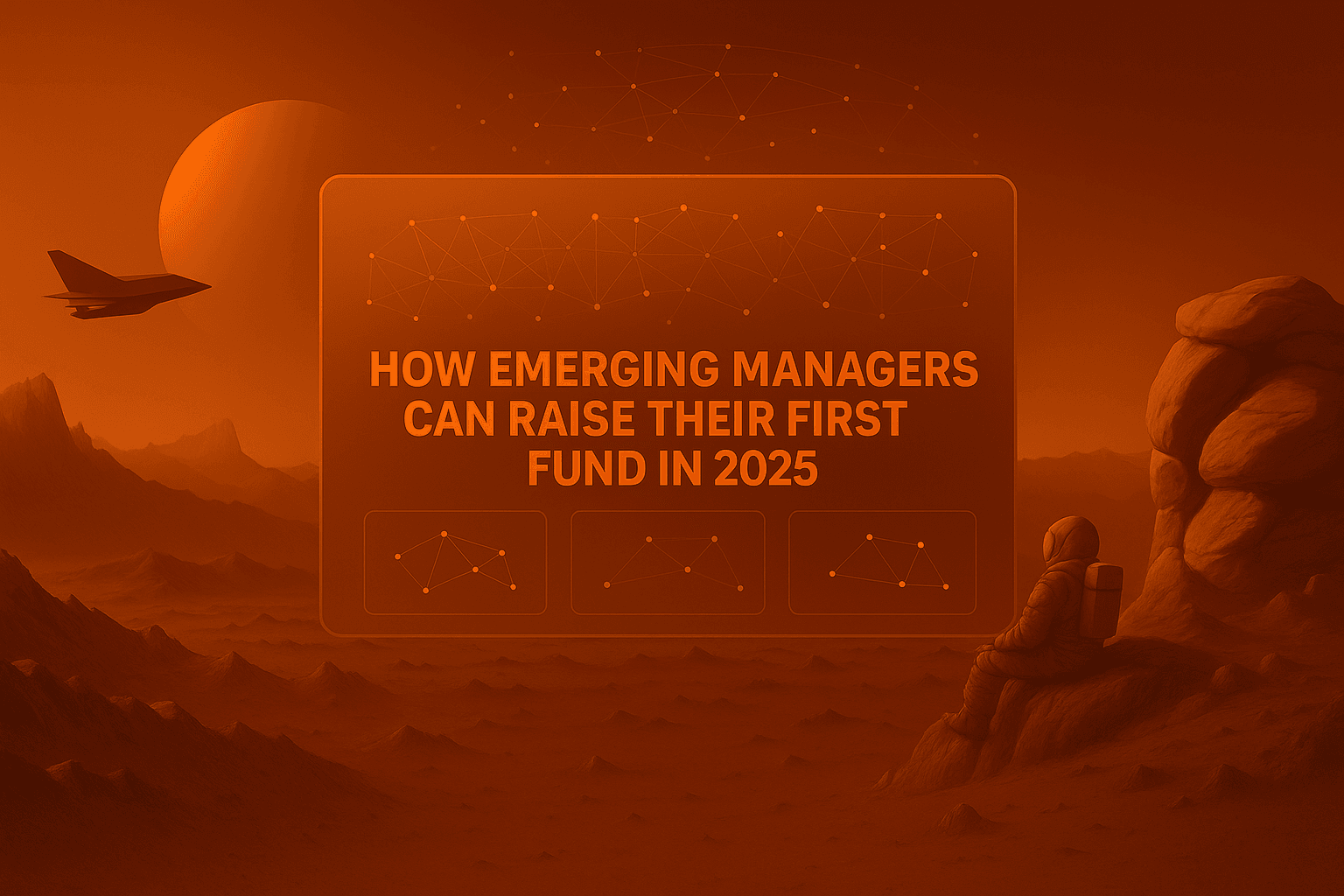Guide to Fundraising in 2025: A Strategic Playbook for Emerging Fund Managers
Emerging managers in 2025 must raise with precision: live mandate alignment, co-investment readiness, and institutional process. This Altss playbook outlines seven disciplines to run a credible fundraise and shows where continuously refreshed LP intelligence creates an edge.

Guide to Fundraising in 2025: A Strategic Playbook for Emerging Fund Managers
Raising a first fund in 2025 is a test of precision. Capital is available, but cycles are tighter and allocators are more targeted. LPs expect personalization, a thesis that actually matches their current interests, and a fundraising process that mirrors institutional rigor from day one. A strong deck and warm references help; timing, mandate alignment, and execution discipline decide outcomes.
This playbook lays out seven disciplines for emerging managers. Each section is written from an allocator-facing perspective and shows exactly where Altss—with continuously refreshed LP profiles (≤30-day cadence) and live mandate signals—reduces friction and increases close probability.
1) Define a focused, data-backed investment strategy
A strategy is investable only when the decision logic and sourcing mechanics are clear. LPs will underwrite a tight mandate with a repeatable edge faster than a broad thesis with hand-waved access.
What to show
- Scope with intent: stage, sector, and geography you will actually prosecute.
- Why now: durable drivers that persist through a full fund cycle.
- How you source: the concrete paths that deliver qualified looks.
- Execution rhythm: pacing, reserves, and your playbook from term sheet to exit.
Altss advantage
Before you publish a sentence, check the allocator reality. With Altss, you can see where family offices and other allocators are actively leaning—by sector, strategy, and region—and tune your narrative to live mandate interest, not last year’s positioning. This is the difference between “thoughtful” and “fundable.”
2) Articulate a defendable competitive advantage
“Why you?” isn’t a tone question; it’s a diligence question. GPs win allocations when their advantage is repeatable and relevant to the LP’s current priorities.
Ways to prove it
- Operator edge that translates into sourcing and underwriting.
- Specialist pattern recognition in a narrow market where generalists hesitate.
- Value-creation muscle: what you do post-close that non-specialists cannot.
- Attribution clarity: if you were part of prior outcomes, show your actual role.
Altss advantage
Frame your advantage in the LP’s language. Altss mandate signals show which allocators are in-market for your theme. Use that to emphasize the parts of your edge that answer the allocator’s “why now?” rather than reciting a generic origin story.
3) Build alignment into your fund structure
No structure, no fund. First-time managers earn trust by being predictable, transparent, and aligned. That starts with straightforward economics and governance that LPs can underwrite quickly.
What alignment looks like
- Plain-English use of proceeds and pacing assumptions that match your pipeline reality.
- IC transparency: who decides, how often, and with what conflict checks.
- Co-investment readiness: process clarity, timing, and governance standards.
- Earned economics: terms that reflect both ambition and track record stage.
Altss advantage
When you know which LPs are actively seeking co-invest or direct exposure, you can approach with deal-level clarity instead of a vague promise. Altss flags co-invest behavior and related signals so you design (and explain) your process for the audiences that actually demand it.
4) Match LP outreach to your fund’s profile
Fundraising speed comes from targeting discipline. A scattershot list wastes months; a segmented pipeline aligned to check sizes, sectors, geographies, and live mandates can pull a first close forward.
How to segment, practically
- Institutional programs (endowments, pensions): pacing-sensitive; formal diligence; value predictability.
- Family offices: thematic; faster to mobilize; expect real co-invest options and direct lines to the IC.
- Funds-of-funds: programmatic; helpful for validation and referenceable diligence.
- HNW syndicates: relationship-driven; often deal-by-deal before blind-pool commitments.
Altss advantage
Altss surfaces who is actually active now—not just who looks like a fit. With 9,000+ verified family offices across NA/EU/APAC and continuously refreshed mandate signals, you filter to LPs that match your fund’s shape and current appetite, then tier your outreach by deployment window.
5) Operate with institutional-grade tech and transparency
Your raise is the first proof of how you’ll run the fund. LPs want structured workflows, clean data, and fast, factual answers. Anything less signals operational drag.
What good looks like
- Data room for diligence, not decoration: pacing, pipeline, reserves, case studies, references—coherent and consistent with your deck.
- Operating dashboards that reconcile investment cadence with reserves and ownership goals.
- Clear communications cadence: updates that are timely, factual, and free of hype.
Altss advantage
Use Altss to pre-contextualize every touch: start a call with the allocator’s recent signal (sector pivot, co-invest activity, region tilt). You’ll spend less time explaining “why us” and more time confirming fit. It reads as prepared and professional—because it is.
6) Assemble a credible, cohesive team
LPs don’t fund organizational experiments. They fund teams that can underwrite risk, move through ambiguity, and stay aligned when markets get messy.
Signals of credibility
- Defined decision rights and a visible IC rhythm.
- Complementary capabilities: sourcing, technical diligence, value creation, exits.
- Aligned incentives: a GP commit that makes sense for your stage; vesting and carry that keep people on the field.
- Referenceable judgment: even without a full track record, show decisions and learnings that reflect discipline.
Altss advantage
Walk into references with context. If an allocator has backed similar teams or themes, tailor your narrative to the gaps they historically probe. Altss’s firm-level histories keep you a step ahead of the diligence line of questioning.
7) Treat fundraising as an iterative GTM motion
The first 10 LP meetings should improve your materials. If they don’t, your process is static.
Run it like GTM
- Capture and categorize objections. Update your FAQ weekly.
- Prioritize by live interest. “Nice to meet you” is not a buying signal; mandate activity is.
- Shorten the opener. A three-slide “why us / why now / proof we can do it” gets you into substantive discussion faster.
Altss advantage
Altss closes the loop: signals → segmentation → outreach → response → refinement. When an allocator rotates out of a theme or opens a new sleeve, you see it and rebalance your pipeline without losing a quarter.
Execution details LPs actually notice
These are small edges that compound into credibility.
- Pacing math that reconciles with market reality and team bandwidth.
- Reserve policy aligned to your strategy (don’t starve the outliers).
- Ownership targets backed by sourcing math, not hope.
- Dataroom integrity: every number syncs across deck, model, and FAQ.
- Update discipline: monthly or quarterly notes that explain what changed and why.
Altss doesn’t write your memo, but it ensures the context behind your memo is current. When your narrative matches what LPs are seeing in their portfolios and networks, meetings move faster.
Final word: your raise is your first investment
Fundraising in 2025 is a live-fire test of operating discipline. The managers who win are those who replace guesswork with signal-driven execution, structure their fund for alignment and speed, and communicate with clarity. The goal is not to talk to everyone; it’s to be unmissable to the right LPs at the right time.
Altss is built for that discipline: continuously refreshed allocator data (≤30-day cadence), real-time mandate tracking, co-invest and warm-path insights, and precision filters that let lean teams operate like institutional platforms.
Outlook: 2026—what to prepare for now
Mandate timing becomes predictive.
Allocators will bring forward the analytical work that precedes mandate shifts. Hiring in new verticals, governance moves, and pacing changes will be detectable earlier—meaning the edge moves to those who align two quarters ahead of the announcement. Altss’s OSINT-driven signals are designed to surface that early movement so your outreach is there first.
Co-investment delivery gets standardized.
“Access” won’t be enough; process will be judged—time to term sheet, governance clarity, and fairness in allocation. Teams that can show reliable co-invest throughput will become default partners for programmatic capital.
Family-office syndicates globalize.
Cross-border family-office groups will scale in AI infrastructure, secondaries, and climate-linked real assets. They will seek managers who can handle both fund structures and deal-by-deal coordination without friction—another argument for operational polish.
Emerging-manager programs professionalize.
Institutional LPs will formalize first-time allocations with defined evaluation lanes: team durability, pacing discipline, and co-invest readiness. The “story” will get you in the room; process will get you in the program.
Continuous refresh becomes the standard.
Static directories will not survive. The allocators you want are adjusting quarterly; your intelligence must match that cadence. Continuous refresh is not a feature—it’s the infrastructure modern fundraising runs on.
About Altss
Altss is the OSINT-powered LP intelligence platform for fund managers, independent sponsors, and capital-raising professionals.
- Coverage: 9,000+ verified family offices across North America, Europe, APAC, and the Middle East.
- Refresh cadence: profiles updated within ≤30 days; mandate signals refreshed continuously.
- Signals: allocator timing, mandate pivots, co-investment history, warm-path identification.
- Pricing: $15,500/year. No CRM integrations, no CSV exports, no reselling.
FAQ
What’s the single biggest shift in 2025?
Timing. Outreach aligned to live mandates beats generic persistence. Your process must see and respect allocator cycles.
Do I need to offer co-investments?
If your target LPs expect direct exposure, yes. Treat it as part of the operating model—clear governance, predictable timelines, and real examples.
How should I diversify my LP base?
By design, not accident. Balance across regions and allocator types, and prioritize those with current activity in your category.
How often should I update materials?
As often as reality changes. Deck, FAQ, pacing model, and dataroom should always reconcile. Treat objections as inputs to the next version.
Where does Altss fit in the stack?
Altss is the front end of fundraising intelligence—the place you confirm who’s active, how they’re moving, and where the warm paths are—so your CRM reflects today, not last quarter.
Book a Demo
Fundraising doesn’t need to be guesswork. See how Altss aligns your capital formation—so every conversation is timely, relevant, and easier to underwrite.
→ Schedule a 30-minute demo and get a tailored walkthrough of mandate tracking, warm-path mapping, and precision targeting for your fund.
Related articles

Anchor Investors for Emerging Managers & Startups: The 2025 Playbook
A step‑by‑step playbook for landing an anchor investor (or LP), understanding anchor vs. lead, structuring first closes, and creating momentum in your round.

How Emerging Managers Can Raise Their First Fund in 2025
How emerging managers can raise their first fund in 2025: a precise, step-by-step playbook that covers allocator targeting, pipeline math, ILPA-aligned diligence, OSINT signals, and modern outreach. Written for GPs and IR teams using verified allocator data and real-time LP coverage.